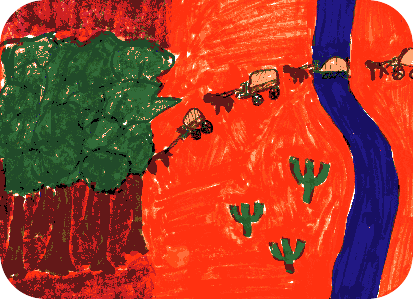Heritage Gateways
Official Sesquicentennial K-12 Education Projectsponsored by the Utah State Board of Education, the BYU-Public School Partnership and the Utah Education Network
Life On The Trail
Mormons and the Environment

Image courtesy of: Heritage Gateway Project Images, These images have been gathered to support the Sesquicentennial celebration of the immigration to Utah.
There is no evidence that the Mormons harmed the environment of the trail. As modern Saints, Mormons tried to be responsible travelers--considerate of the land and game. Killing for sport, for example, was prohibited and they were usually careful in their consumption of trees for fuel. Perhaps the main reason for the Mormon concern with the environment is that they knew thousands of their faith would be using the same trail. The Mormons were interested in the environment, in the flora and fauna of the increasingly strange world they encountered while westering. Their journals record their pleasure with the dramatic landscapes they traversed. Occasionally some pioneers found time to do some "botanizing" and what we might call "geologizing." In what is now Nebraska, in 1847, for example, they were fascinated by mammoth bones.
The author has found scores of Mormon Trail account references to land features, plants, and animals. They noted, for example, such plants as wild onions, buffalo grass, willows, roses, violets, gooseberries, strawberries, clover, bunch grass, vines, elderberries, thistles, cacti, garlic, currants, mint, sage, rushes, and cedar, ash, cherry, oak, maple, apple, alder, birch, poplar, cottonwood, and pine trees. They also noted squirrels, ducks, snapping turtles, various kinds of fish, goose, lizards, skunks (with which some foreign emigrants had unpleasant experiences), prairie dogs, rattlesnakes, antelope, hares, wolves, buffalo, badgers, deer, crickets, spiders, toads, ants, mosquitoes, mice, eagles, hawks, cranes, martins, pheasants, and magpies--to name a representative sampling.
At times they even ventured to try to describe some unusual living things. One described something, perhaps a horny toad, as being "four to five inches long, including a long tail, body short and chunky, light grey, two rows of dark spots (brown) on each side, head shaped like a snake, appears perfectly harmless." Another described a plant as "a thistle, stem four feet long, six inches wide, one quarter inch thick, ornamented by prickles top to bottom, top is kind of a crown formed by prickly leaves ten inches long and five inches broad."
Source: Historic Resource Study - Mormon Pioneer National By Stanley B. Kimball, Ph.D., May 1991. (The study focuses on the history of the trail from its official beginning in Nauvoo, Illinois, to its terminus in Salt Lake City, Utah, during the period 1846-1869. During that time, thousands of Mormon emigrants used many trails and trail variants to reach Utah. This study emphasizes the 'Pioneer Route' or 'Brigham Young Route' of 1846-1847. The sections on Mormon beliefs and motivations for going west have been omitted. Interested persons can find ample sources for that information. The footnotes, bibliography, maps, pictures, pioneer companies by name and dates for the 22-year period, and historic sites - about 2/3 of the book - have also been left out for space considerations. Thanks to Dr. Kimball and the National Park Service for the availability of this information.)